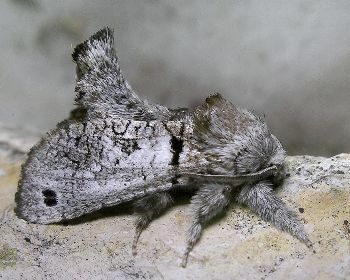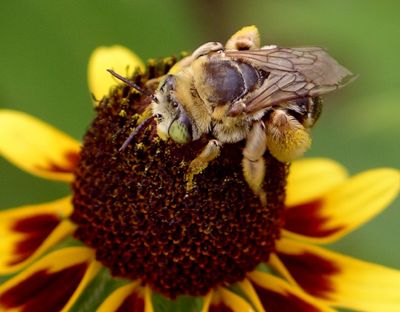
An undescribed cossid moth in the genus Inguromorpha
Remember those questions on IQ tests that compare one kind of thing with another, and the correct answer involves knowing the relationship between them so you can recognize a similar affiliation between two other things? They are verbal reasoning analogies, generally presenting a statement like "Sheep is to mutton as pig is to _" and followed by four choices of varying appropriateness (like: a. skin, b. farm, c. pork, d. truffle). Not only are these fairly easy for native English speakers, but they are an amusing game as well. Of course, the objects that are being compared can range from the relatively familiar to the totally obscure, so the difficulty of the question depends on knowing the meaning of each term used. Not many people will find "Taupe is to fuscous as mauve is to a. puce, b. fulvous, c. ecru, d. chartreuse" quite as simple.
This sort of word play came to mind because I study taxonomy and, like everyone else, I am amused by correlations, patterns and synchronicity. When I teach entomology, I sometimes use analogies to describe groups of insects, which can help neophytes visualize how an unfamiliar segment of the animal kingdom fits into the ungainly large picture they are beginning to explore. Birders frequently become interested in butterflies when they have become very expert and wish to learn a new set of observational and recognition skills, as well as maybe forego the cold early mornings in favor of sunny mid-days. All I have to do is tell them that "skippers are the sparrows of the butterfly world," and they immediately grasp that these species will be challenging to identify as they are all very small, similar and drab.
Learning to identify insects involves so many different taxons that it always makes sense to first learn the major groups (orders), something that is not as necessary when learning about vertebrates. Whereas there are just over 900 species of birds that occur in the United States, there are around 30,000 species of beetles, which are just one order of insects. Sometimes it is hard to even figure out if a particular insect actually IS a beetle, or maybe something else. Nobody will confuse a duck with a heron, but plenty of people regularly mistake a fly for a bee. Even allowing for the fact that ALL insects are small, which creates its own challenges for identification, there are still an enormous number of different kinds. Very few people will see every kind of bird found in our country during their lifetimes, and it is even more farfetched to think of seeing all the insect species. Not only are there beetles, but there are also leafhoppers, ants, dragonflies, katydids, fleas, mantises, aphids and on and on. Obviously, it is not practical to learn the species one at a time. So we start by learning the orders, and if we are very ambitious, we next attempt the families. The gold standard is, of course, to recognize a particular insect to the species level, but genus is usually considered pretty darn good.
 An undescribed cossid moth in the genus Inguromorpha |
The preceding introduction was included as background because there is a very curious relationship among some groups of insects. It boils down to this analogy: butterfly is to moth as bee is to wasp. In the U.S., both the lepidoptera and the hymenoptera contain between 75 and 80 families. These are huge orders, even by insect standards. Lepidoptera is the order that encompasses moths and butterflies, with the latter accounting for just 6 families. Obviously, moths are far more numerous, but there are features common to butterflies that make them win the popularity contest, so that out of all those families, the majority of casual observers notice members of only six. Because of this preference, there are a vast number of books about butterflies, people garden to attract them, and there are even clubs for hobbyists who like watching and photographing them. Every species of butterfly has been intensely studied, given a standardized common name, and the complete life cycles, including caterpillars and host plants, are well known.
Moths, on the other hand, are about 20 times more diverse than butterflies. There are species that are far smaller, as well as bigger, some for which the caterpillars are unknown, some that have never been formally described and named, and their forms are more varied. Looking at the family tree of lepidoptera, one has to search a bit to locate just which branches belong to butterflies, as they are grouped near the middle, with various moth families on either side. I'm often asked how to tell a butterfly from a moth, and the simple answer is: learn your butterflies and everything else is a moth. If a person living here in Austin can recognize 100 species of butterflies, that will cover 99% of what they will see. The rarities often look quite similar, so they could recognize those enough to look them up in a field guide. The "everything else" includes over 2,000 species of moths. I've personally seen fewer than half of them, so it is quite a challenge to really learn their names, most of which are restricted to only the Latin binomials. For the curious, features that separate the two groups are as follows: Butterflies are all diurnal, cannot fold their wings down and back over their bodies, have clubs at the tips of their antennae, don't respond much to sounds, and tend to be fairly colorful. Moths are mostly nocturnal and can fold their wings over their bodies, have thread-like or feathered antennae, react to sounds, and are frequently more cryptically colored.
 Svastra petulca, a digger bee |
There is one more pair of taxons that fit this same analogy, and it is rather surprising to non-entomologists: butterfly is to moth as termite is to, get this, cockroach! Yes, it has been known for a long time that termites and roaches are closely related, but recent DNA analysis has clarified the relationship and it is not that termites sit next to roaches on the phylogenetic tree but that they are actually nestled within the roach branches. Basically, termites are a subset of cockroaches, which seems to have a kind of poetic irony to it, as they are both among our most loathed pests. While blattodea does not contain nearly as many families as lepidoptera or hymenoptera, the same pattern occurs, with 2 families (in our area) of termites snuggled as a group between 4 families of cockroaches. Termites are, in the end, just eusocial roaches with a penchant for eating our houses.